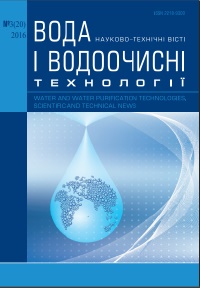BARBOTINE ACTIVATING SOLUTIONS AND THE ROLE OF THIS PHENOMENON IN NATURAL AND TECHNOLOGICAL PROCESSES
DOI:
https://doi.org/10.20535/2218-93002032016122678Keywords:
salt solutions, barbotage of passive gases, structural temperature of water, structural activation, structural quasi equilibrium, chemical resistance of metalsAbstract
The possible molecular mechanisms of water structuring and between the surfaces of gas/water in the solutions are considered. It was shown that barbotage activation (BA) occurs by increasing the structural temperature of water and causes increasing of chemical activity of H2O and dissolved oxygen. It is established that BA has quasi equilibrium character. Therefore external influences on the lines of changes of pH and Eh characteristic peaks or steps appear that can be used to investigate the interaction of solutions with different solid materials. The proposed model of structural transformation may explain why negatively charged bubbles of gas form positively charged droplets of sea spray.
References
Букатый В. И. Измерение физико-химических характеристик воды при различных физических воздействиях с учетом переходных процессов / В. И. Букатый, П. И. Нестерюк // Ползуновский вестник. — 2010. — № 2. —С. 60—65.
Хорн Р. Морская химия (структура воды и химия гидросферы) / Р. Хорн. — М.: Мир, 1972. — 398 с.
Антонченко В. Я. Основы физики воды / В. Я. Антонченко, А. С. Давыдов, В. В. Ильин. — К.: Наук. думка, 1991. — 672 с.
Кушнір С. В. Барботажний хімічний ефект і його вплив на властивості морської води / С. В. Кушнір, М. В. Кость, Р. П. Козак // Доповіді НАН України. — 2015. — № 2. — С. 89—95.
Кушнір С. В. Причини барботажного хімічного ефекту і диференціації іонів при утворенні морських аерозолів (фізико-хімічний аналіз) / С. В. Кушнір // Доповіді НАН України. — 2015. — № 7. — С. 91—98.
Кушнір С. Структура і властивості чистої води за різних термобаричних умов (фізико-хімічний аналіз) / С. Кушнір // Мінералогічний збірник. — 2012. – № 62. — Вип. 2. — С. 236—245.
Bandura A. V. The ionization Constant of Water over Wide Ranges of Temperature and Density / A. V. Bandura, S. N. Lvovs // J. Phys. Chem. Ref. Data. — 2006. — 35, No 1. — P. 15—30.
Maheshwary S. Structure and Stability of Water Clusters (H2O)n, n=8-20: An Ab Initio Investigation / S. Maheshwary, N. Patel, N. Sathyamurthy, A. D. Kulkarni, S. R. Gadre // J. Phys. Chem. A. — 2001. — V. 105. — P. 10525—10537.
Neela J. I. Hydrogen Bonding in Water Clusters and Their Ionized Counterparts / J. I. Neela, A. S. Mahadevi, G. N. Sastry // J. Phys. Chem. B. — 2010. — V. 114. — P. 17162—17171
Киров В. М. F-структура полиэдрических кластеров воды / В. М. Киров // Журн. Структурной химии. — 1992. — Т. 34. — № 4. — С. 77—82.
Антропов Л. І. Теоретична електрохімія / Під ред. В. П. Ріжко. – К.: Либідь. — 1993. — 546 с.
Chaplin M. Theory VS Experiment: What is the Surface Charge of Water? / M. Chaplin // Water. — 2009. — No 1. — P. 1—28.
Hong-tao Bian Specific Na+ and K+ cation effects on the interfacial water molecules at the air/aqueous salt solution interfaces probed with nonresonant second harmonic generation / Bian Hong-tao, Feng Ran-ran, Guo Yuang, Wang Hong-Fei // J. Chem. Phys. — 2009. — 130. — P. 134709/1—11.
Heather C. Allen Shedding light on water structure at air–aqueous interfaces: ions, lipids, and hydration / C. Allen Heather, N. Casillas-Ituarte Nadia, M. Roxana Sierra-Herna´ndez, Chen Xiangke and Y. Cheng // Phys. Chem. Chem. Phys. — 2009. — V. 11. — P. 5538—5549.
Bauer B. A. Solvation structure and energetics of single ions at the aqueons liquid-vapor interface / B. A. Bauer, S. Ou, S. Patel // Chem. Phys. Lett. — 2012. — V. 527. — P. 22—26.
Published
How to Cite
Issue
Section
License
Copyright (c) 2020 С. В. Кушнір, М. В. Кость

This work is licensed under a Creative Commons Attribution-NonCommercial 4.0 International License.
The ownership of copyright remains with the Authors.
Authors may use their own material in other publications provided that the Journal is acknowledged as the original place of publication and National Technical University of Ukraine “Igor Sikorsky Kyiv Polytechnic Institute” as the Publisher.
Authors are reminded that it is their responsibility to comply with copyright laws. It is essential to ensure that no part of the text or illustrations have appeared or are due to appear in other publications, without prior permission from the copyright holder.
WPT articles are published under Creative Commons licence:
- Authors retain copyright and grant the journal right of first publication with the work simultaneously licensed under CC BY-NC 4.0 that allows others to share the work with an acknowledgement of the work's authorship and initial publication in this journal. The use of the material for commercial purposes is not permitted.
- Authors are able to enter into separate, additional contractual arrangements for the non-exclusive distribution of the journal's published version of the work (e.g., post it to an institutional repository or publish it in a book), with an acknowledgement of its initial publication in this journal.
- Authors are permitted and encouraged to post their work online (e.g., in institutional repositories or on their website) prior to and during the submission process, as it can lead to productive exchanges, as well as earlier and greater citation of published work.

